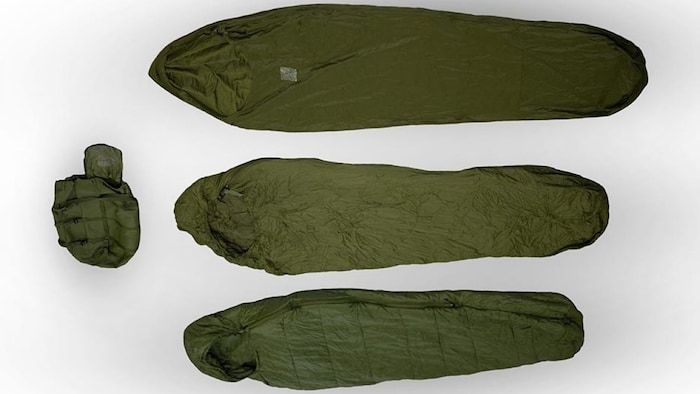Canada News
Canadian Army says new military sleeping bags not suitable for ’typical Canadian winter’
By Murray Brewster, CBC News, RCI

Canadian Army soldiers from 3rd Battalion, Royal 22e Régiment, prepare to move out from a landing area after disembarking from a CH-147 Chinook helicopter in the training area of Fort Greely, Alaska, during training at the Joint Pacific Multinational Readiness Center on March 16, 2022. (Master Sailor Dan Bard, Canadian Forces Combat Camera, CAF photo)
Photo: (Master Sailor Dan Bard, Canadian Forces Combat Camera, CAF photo)
‘I wonder if they should have just gone to Canadian Tire,’ says defence expert
Despite the defence department spending more than $34.8 million on new sleeping bags, the Canadian Army asked late last year that hundreds of soldiers headed to a joint northern exercise in Alaska with the Americans be issued with old, 1960s-vintage bedrolls.
Troops who had used the recently issued General Purpose Sleeping Bag System (GPSBS) late last fall in a preparatory exercise found several critical issues,
according to an internal briefing note obtained by CBC News.
More than 350 soldiers belonging to the 3rd battalion Princess Patricia’s Canadian Light Infantry (3 PPCLI) deployed to Ram Falls Provincial Park, west of Red Deer, Alta., in late November last year, where they spent several days training for northern operations.
Temperatures during the deployment ranged from – 5C during the day to – 20C at night.
The critical issues
discovered by the soldiers related to lack of warmth with the new GPSBS,
said the briefing note, written on Dec. 5, 2023.
The general unsuitability of the new sleeping bag system has prompted the Department of National Defence (DND) to start looking to buy additional bedrolls that can be used in the Far North.
During the training exercise last fall, soldiers reported that even though they used both the inner and outer shells and slept in tents heated by stoves, they were still cold.
According to the internal briefing note, 3 PPCLI’s quartermaster concluded the new sleeping bags were better suited for use in weather conditions that are characteristic of late spring to early fall
and were not practical for typical Canadian winter conditions nor the extreme cold of Alaska,
where the troops deployed for further training in January.

The Canadian Army’s recently-issued General Purpose Sleeping Bag System (GPSBS). (DND Handout)
Photo: (GPSBS). (DND Handout)
The briefing note recommended that soldiers deployed on that exercise with the U.S. be loaned
500 of the army’s old Arctic sleeping bags — the ones the new system was meant to replace.
The Liberal government has placed renewed emphasis on defending Canada’s Arctic and the recent defence policy update — Our North Strong and Free — promised a series of new equipment purchases for cold weather operations. Specifically, the policy promised to acquire new vehicles adapted to ice, snow and tundra.
But several soldiers who contacted CBC News with complaints about the sleeping bags said they’re skeptical about those promises, given DND’s failure to deliver on something as basic as a sleeping bag suitable for a Canadian winter.
In a statement, DND said 3 PPCLI was actually the second unit to complain about the new sleeping bags.
Troops belonging to the 2nd battalion Royal Canadian Regiment (2RCR) also found the new sleeping bags flawed on a separate exercise.
Still, the department said it’s not giving up the new bedrolls and has started a second, separate procurement for sleeping bags that are suitable for a Canadian winter.
The GPSBS remains a core component of the Canadian Armed Forces’ sleeping system and is expected to stay in service for many years,
the statement said.
However, we recognize the need for enhanced protection in extreme environments, which is why we have issued a request for proposals (RFP) for an Extreme Cold Weather Sleeping Bag system (ECWSBS) initiative. This additional procurement will complement the GPSBS, ensuring coverage across all climatic conditions, including the Arctic.
DND hasn’t said if bags were weather-tested
Defence expert Rob Huebert of the University of Calgary said he wonders what sort of cold weather testing was conducted on the new sleeping bags before they were ordered.
I wonder if they should have just gone to Canadian Tire,
said Huebert, an expert in Arctic military affairs. You test to make sure that the new kit works, because it does not always work.
In its statement, DND said it sought feedback from soldiers — but the department did not answer directly when asked what sort of cold weather testing was done before it chose to purchase the sleeping bags.
The GPSBS was chosen following a rigorous competitive process,
said the department’s statement.
The technical requirements used to make the selection included insulation value, weight of the bags and the packing volume.
The problem, Huebert said, is that defence planners sometimes feel they need to reinvent the wheel when looking for replacement equipment.
The so-called legacy
sleeping bags, which the army first acquired in 1965, are an example of something simple that required a straightforward procurement solution, he said.
We’re getting such difficulties and challenges from a no-brainer, such as sleeping bags,
said Huebert. And when you start thinking about the over-the-horizon radars, the F-35 and its parts, and presumably the submarines, at one point — I mean, it just does not fill one with too much confidence.
This article is republished from RCI.





















